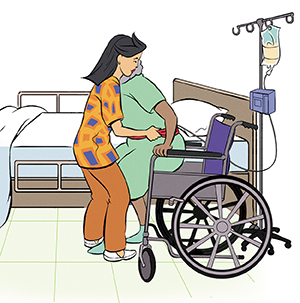Moving Patients from Bed to Wheelchair
Patient safety is often the main concern when moving patients from bed. But remember not to lift at the expense of your own back. This transfer often requires the patient's help, so clear communication is essential. If the patient can’t help much or isn't cooperative, you’ll need two people or a fully body sling lift. For a cooperative patient who can support some of their own weight, follow the steps below.
 |
| Using a transfer belt can help make moving patients safer. |
Remember
When patients are weak, brace your knees against theirs to keep their legs from buckling. Also, transfer toward the patient’s stronger side if possible.
Step 1. Sit the patient up
-
Position and lock the wheelchair close to the bed. Remove the armrest nearest to the bed, and swing away both leg rests.
-
Help the patient turn onto their side, facing the wheelchair.
-
Put an arm under the patient’s neck with your hand supporting the shoulder blade; put your other hand under the knees.
-
Swing the patient's legs over the edge of the bed, helping the patient to sit up.
Step 2. Stand the patient up
-
Have the patient scoot to the edge of the bed.
-
Assist the patient in putting on skid-proof socks or shoes.
-
Put your arms around the patient’s chest and clasp your hands behind their back. Or, you may also use a transfer belt to provide a firm handhold.
-
Supporting the leg farthest from the wheelchair between your legs, lean back, shift your weight, and lift.
Step 3. Pivot toward chair
-
Have the patient pivot toward the chair, as you continue to clasp your hands around the patient.
-
A helper can support the wheelchair or patient from behind.
Step 4. Sit the patient down
-
As the patient bends toward you, bend your knees and lower the patient into the back of the wheelchair.
-
A helper may position the patient’s buttocks and support the chair.
-
Reposition the foot rests and the patient's feet.
© 2000-2024 The StayWell Company, LLC. All rights reserved. This information is not intended as a substitute for professional medical care. Always follow your healthcare professional's instructions.